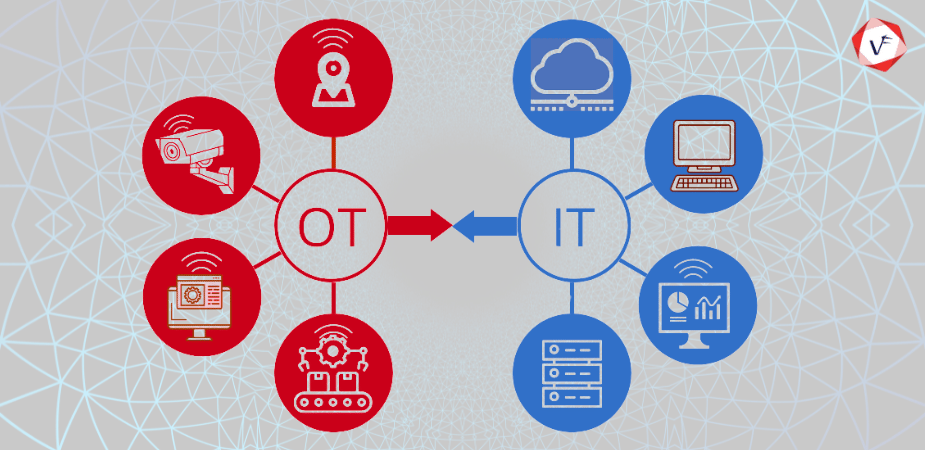Networks are the backbone of many operations, from businesses to factories. Two types of networks often come up in discussions: Operational Technology (OT) and Information Technology (IT) networks. Despite their apparent similarities, they have separate functions and unique qualities. This blog will explore the differences between OT and IT networks in simple terms, helping you understand how each works and why they are important.
What Are IT Networks?
IT networks are the systems that support communication and data exchange in office environments and other business settings. They include computers, servers, routers, and other devices that help manage and distribute information.
Common Uses
- Email and Communication: IT networks enable email, video conferencing, and other communication tools.
- Data Storage and Management: These networks support databases, file servers, and cloud storage.
- Business Applications: IT networks run software for tasks like accounting, customer relationship management (CRM), and enterprise resource planning (ERP).
- Internet Access: They provide access to the internet and internal websites.
What Are OT Networks?
OT networks are designed to manage and control physical processes and machinery. They are commonly used in industrial environments such as manufacturing plants, power plants, and other infrastructure facilities.
Common Uses
- Industrial Control Systems (ICS): These include systems like Supervisory Control and Data Acquisition (SCADA) and Distributed Control Systems (DCS) that control machinery and processes.
- Automation: OT networks support automated production lines and robotic systems.
- Monitoring and Safety: They track the performance of machinery and ensure safety protocols are followed.
- Process Control: OT networks maintain the correct operation of processes like chemical production or water treatment.
Key Differences Between IT and OT Networks
Primary Function
- IT Networks: Focus on data-centric tasks such as communication, information storage, and business applications.
- OT Networks: Focus on controlling and monitoring physical devices and processes in industrial settings.
Performance Requirements
- IT Networks: Prioritize data speed, bandwidth, and security for efficient information processing.
- OT Networks: Prioritize reliability, real-time performance, and stability to ensure continuous operation of physical processes.
Security Concerns
- IT Networks: Face threats like data breaches, malware, and hacking, which can compromise sensitive information.
- OT Networks: Face threats that can disrupt physical processes, potentially causing safety hazards or damage to equipment.
Network Design and Architecture
- IT Networks: Typically use standard protocols and have a more flexible architecture, with frequent updates and changes.
- OT Networks: Use specialized protocols and have a rigid architecture to maintain stability and reliability. Updates are less frequent and carefully managed.
Lifespan of Equipment
- IT Networks: Equipment has a shorter lifecycle, often replaced every few years to keep up with technological advancements.
- OT Networks: Equipment has a longer lifecycle, sometimes decades, due to the high cost and critical nature of industrial machinery.
Integration of IT and OT Networks
In recent years, there has been a trend toward integrating IT and OT networks to improve efficiency and innovation. This integration, often referred to as the Industrial Internet of Things (IIoT) or Industry 4.0, allows for better data analysis and decision-making.
Benefits of Integration
- Enhanced Data Collection: Combining IT and OT networks allows for comprehensive data collection from both business operations and industrial processes.
- Improved Efficiency: Integration can streamline operations, reducing downtime and improving productivity.
- Predictive Maintenance: Data from OT networks can be analyzed using IT tools to predict when machinery will need maintenance, preventing unexpected failures.
- Real-Time Insights: Businesses can gain real-time insights into their operations, leading to faster and more informed decision-making.
Challenges of Integration
- Security Risks: Integrating the two networks can create new vulnerabilities, as IT security practices might not be directly applicable to OT environments.
- Complexity: Combining different systems and protocols can be complex and require significant changes to existing infrastructure.
- Cultural Differences: IT and OT teams often have different priorities and ways of working, which can create challenges in collaboration.
Security Considerations
Both IT and OT networks have unique security challenges, and it’s crucial to address these to protect against threats.
IT Network Security
- Firewalls and Antivirus Software: Protect against unauthorized access and malware.
- Encryption: Ensures data is secure during transmission and storage.
- Access Controls: Limits who can access sensitive information and systems.
- Regular Updates: Keeps systems protected against the latest threats by applying software patches and updates.
OT Network Security
- Network Segmentation: Separates different parts of the network to contain potential security breaches.
- Strict Access Controls: Ensures only authorized personnel can access critical systems.
- Monitoring and Incident Response: Continuously monitors for unusual activity and has plans in place to respond to incidents.
- Vendor Management: Ensures that third-party vendors follow strict security protocols.
Future Trends
As technology continues to evolve, so will the roles and capabilities of IT and OT networks. Here are a few upcoming trends to be aware of:
- Increased Integration: More businesses will integrate IT and OT networks to take advantage of the benefits of IIoT and Industry 4.0.
- Advanced Security Measures: New security technologies and practices will emerge to address the unique challenges of integrated networks.
- Artificial Intelligence (AI) and Machine Learning: These technologies will be increasingly used to analyze data from IT and OT networks, improving efficiency and decision-making.
- Edge Computing: Processing data closer to where it is generated (at the “edge” of the network) will reduce latency and improve the performance of both IT and OT networks.
- Sustainability: Both IT and OT networks will focus more on sustainable practices, reducing energy consumption and environmental impact.
Final Thoughts
Understanding the differences between OT and IT networks is crucial for businesses to leverage their unique strengths and address their specific challenges. While IT networks are essential for managing data and supporting business operations, OT networks are vital for controlling and monitoring physical processes in industrial environments. As technology advances, the integration of these networks will continue to drive innovation and efficiency, making it more important than ever to understand and manage both effectively.
Whether you’re a business owner, a network manager, or just someone interested in technology, appreciating the distinctions and synergies between IT and OT networks can help you navigate the complexities of the modern digital and industrial landscape.





